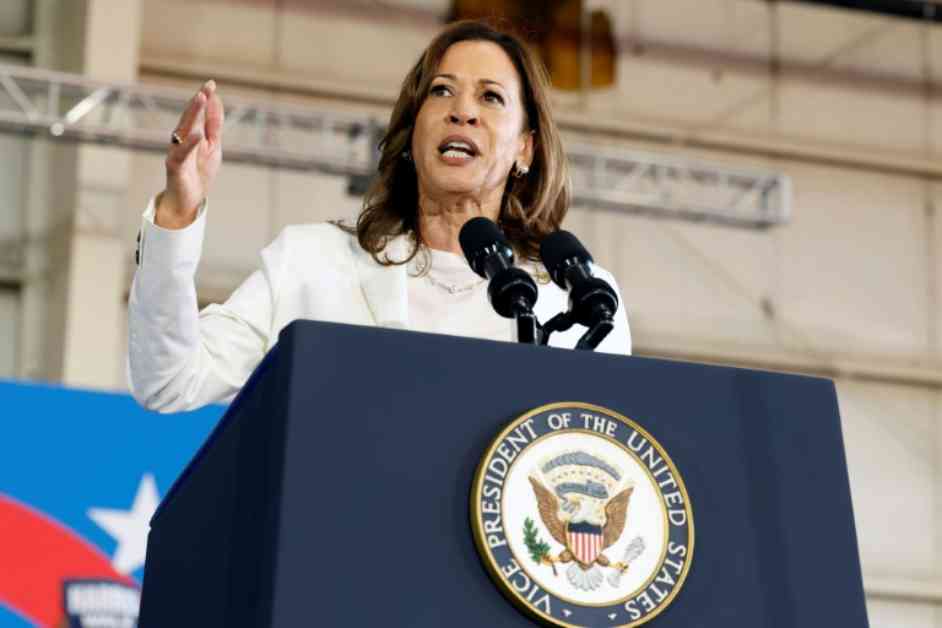US Vice President Kamala Harris has put forth a detailed strategy to reduce living costs for Americans amidst growing concerns over inflation and elevated prices. A recent YouGov survey of over 1,500 US adults highlighted that these economic issues are at the forefront of voters’ minds, alongside worries about the weakness in the job market and overall economy. With the US economy deeply entrenched in debt, both Harris and former President Donald Trump are vying to win over voters by focusing on economic revitalization.
Harris’s Economic Agenda to Lower Living Costs
During a speech in North Carolina, Harris outlined her economic agenda, which primarily focuses on lowering living costs through various measures. One key proposal is to ban price gouging on groceries, as she believes that prices remain excessively high despite improvements in global supply chains post-pandemic. Harris also plans to assist families with newborns by offering a $6,000 tax credit and providing $25,000 in downpayment assistance for first-time homebuyers.
In a recent interview with CNN, Harris reiterated her commitment to reducing the cost of goods during her tenure in office. She emphasized the need to address the high prices of groceries, stating, “Prices in particular for groceries are still too high…The American people know it. I know it. Which is why my agenda includes what we need to do to bring down the price of groceries, what we need to do to extend the child tax credit to help young families be able to take care of their children in their most formative years, what we need to do to bring down the cost of housing.”
Criticism of Harris’s Economic Agenda
Despite Harris’s ambitious plans, some economists are skeptical about the effectiveness of her proposed price-gouging ban. William Ruger, president of the American Institute for Economic Research, expressed concerns about the feasibility of Harris’s agenda, labeling it as “unrealistic and dangerous.” Ruger warned that attempting to control prices through regulations could lead to shortages and the emergence of black markets, ultimately exacerbating the problem.
Marc Goldwein from the Committee for a Responsible Federal Budget also cast doubt on Harris’s approach, suggesting that no candidate has a comprehensive plan to combat inflation effectively. Goldwein highlighted the importance of reducing deficits, healthcare expenses, and improving supply in the economy as key factors in addressing rising living costs.
University of Michigan economics professor Justin Wolfers echoed similar sentiments, noting that while Harris has provided detailed insights into her economic strategy, Trump has not offered any concrete plans to tackle the cost of living. Wolfers emphasized the need for policy specifics to address economic challenges effectively.
Trump’s Critique of Harris’s Agenda
In contrast to Harris’s proposals, former President Donald Trump has criticized her price-gouging ban as a “Communist Plan.” Trump argued that similar measures have been tried in the past without success, casting doubt on the efficacy of Harris’s approach. If re-elected, Trump pledged to lower inflation within the first 100 days of his second term to alleviate the burden of high living costs on Americans.
Trump’s Economic Plans
Trump outlined several initiatives aimed at reducing living costs, including eliminating taxes on Social Security payments to benefit millions of seniors. He also proposed ending taxes on tips for workers as part of his economic agenda. However, Professor Wolfers raised concerns about Trump’s proposed policies, such as increasing tariffs on imported goods, which could potentially raise living costs for consumers. Wolfers pointed out that higher tariffs often lead to price hikes for both imported and domestic goods, ultimately impacting consumers’ wallets.
Conclusion
As the 2024 elections draw near, the debate over how to address rising living costs in the US continues to intensify. While Vice President Kamala Harris has laid out a comprehensive economic agenda focused on reducing prices and supporting American families, critics question the feasibility and effectiveness of her proposals. On the other hand, former President Donald Trump has offered his own set of economic plans, including tax cuts and tariff adjustments, to address the challenges facing American households.
Ultimately, the path to lowering living costs for Americans will require a combination of sound economic policies, fiscal responsibility, and targeted interventions to support those most affected by inflation and price increases. The upcoming election will undoubtedly shape the future direction of the US economy and determine how policymakers address the pressing issue of affordability for American families.













